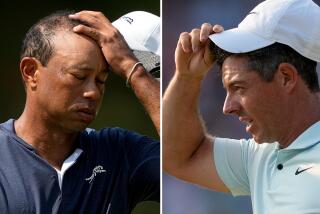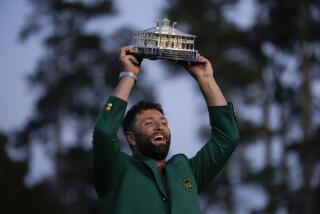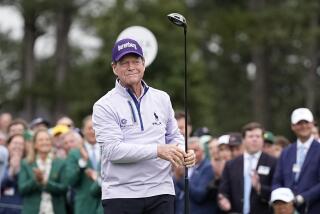At Masters, Woods seeks a quiet return
- Share via
Immense hedges and thickets of azaleas surround Augusta National Golf Club, concealing its picturesque fairways from the outside world.
Fans at the club’s annual Masters tournament are known for their gentility -- they are referred to as “patrons” -- and media access is tightly controlled.
So it makes sense that Tiger Woods would choose the Masters as a suitable place to emerge from seclusion, the troubled superstar announcing Tuesday he will resume his career in early April after months of wrestling privately with the fallout from his widely reported extramarital affairs.
“The Masters is where I won my first major, and I view this tournament with great respect,” he said in a statement on his website. “After a long and necessary time away from the game, I feel like I’m ready to start my season at Augusta.”
The controlled environment of The Masters is also a perfect spot for Woods to return to the sport after a carefully orchestrated rehabilitation. There are few details left unattended. Commercial signage, such as on fountain drink dispensers, is shielded. The food you buy comes wrapped in green paper so as to not sully the course.
It’s the only tournament where the media is not allowed inside the ropes and members run the news conferences. The patron badges are limited to a number that has never been disclosed. And television is even limited to the numbers of commercials it can show.
There is much at stake for Woods, trying to reclaim his status as a preeminent athlete and a marketing juggernaut who once earned more than $100 million annually in endorsements.
Though Augusta offers a cloistered setting, he will nonetheless be in the public eye, playing on golf’s biggest stage and one of its most challenging courses.
“I mean, it’s going to be tough,” said Matt Killen, a swing coach who works with PGA Tour players such as Kenny Perry and Josh Teater. “He hasn’t been competitive in a while and being competitive is something that players usually like to warm back up to.”
Woods has remained largely hidden since the November night when he ran his car over a fire hydrant and smashed into a neighbor’s tree. The accident touched off a frenzy of media reports about his liaisons with various women.
Big-money sponsors such as AT&T and Accenture severed ties with the golfer whose image had once been squeaky clean. Woods was subsequently photographed outside a clinic for sex addicts in Mississippi amid rampant speculation about the future of his marriage.
After releasing a series of terse comments on his website, he finally appeared before cameras in February, looking pale and shaken while giving a prepared speech.
On Tuesday, he said: “I have undergone almost two months of inpatient therapy, and I am continuing my treatment. Although I’m returning to competition, I still have a lot of work to do in my personal life.”
At the very least, his return has television executives hoping for record viewership during the Masters. The first two rounds will be broadcast on ESPN, the final two on CBS.
Asked about Woods’ return last week, CBS News and Sports President Sean McManus told AP: “My only prediction is when he comes back, it will be, other than the Obama inauguration, one of if not the biggest media spectacle in recent memory.”
The largest television audience ever for the Masters was in 1997, when 15.8 million people watched the final round as Woods won the tournament for the first time. The second-largest audience was in 2001 when he won it for a second time. But in both instances, millions watched but few could get close. Woods could be both public and private at the same time.
PGA Tour officials seemed equally enthusiastic in welcoming Woods back to a game that has missed his star power. So did those corporate sponsors who stayed with him through the controversy.
“Like many sports fans around the world, we’re looking forward to seeing Tiger back on the course,” a Gillette spokesman said.
But sponsors and well-wishers won’t help Woods when he needs to hit a wedge shot to within 10 feet of the flagstick.
Woods has won 71 PGA tournaments during a 14-year pro career and his 14 victories in “major” tournaments -- the Masters, U.S. Open, PGA Championship and British Open -- rank second to Jack Nicklaus’ 18. This will be the fourth time that Woods has returned from a prolonged absence.
The first time Woods missed time was a two-month break after the death of his father in 2006. He missed the cut at the U.S. Open that year. More recently, he missed two months because of knee surgery in 2008, came back to win the U.S. Open in a thrilling playoff over Rocco Mediate, then missed the last six months of that year, during which he had knee surgery.
“He’ll get a completely different reaction this time,” said Richard Burton, a sports management professor at Syracuse University. “If people believe he cheated on his wife, there’s going to be very little sympathy.”
At the Masters, he will face questions from the reporters he has so far avoided.
“It all depends on how well he can compartmentalize,” said Joe Parent, an Ojai sports psychologist who wrote “Zen Golf” and has worked with professional golfers such as Vijay Singh and David Toms. “He can choose how to answer [reporters]. He can say, ‘I’m not taking questions about anything other than the tournament.’ ”
Augusta is known for being choosy when it comes to the media and isn’t likely to allow access to any of the tabloid reporters who have focused on Woods of late. Fans will be just as tightly monitored.
“They have hard and fast rules that go way back to the Bobby Jones era of the 1930s,” said Eddie Merrins, the head pro at Bel-Air Country Club and a former tour player.
Anyone who heckles, Merrins said, “will be ushered out and his ticket will be removed forever.”
From a golf perspective, Woods should be comfortable playing on a course where he has won four times. Still, swing coach Killen said that preparing without benefit of warmup tournament will be key.
“Hitting the ball and scoring are two different animals,” he said. “He’ll probably spend a lot of time on the scoring shots, the wedges and the putter.”
His score could go a long way toward determining whether Woods can regain his previous stature.
“Most people will take a wait-and-see attitude,” Burton said. “If he starts winning again and goes on a tear and seems sorry, and if he is making progress in his rehab, the whole concept of forgiveness may be attractive to sponsors.”
Fellow tour player Heath Slocum told the Associated Press that could weigh on Woods come early April.
“It will be interesting to watch -- not only the reaction from him, but from the fans, the media, the players,” Slocum said. “I would venture to say he might be nervous.”
Staff writer Diane Pucin contributed to this report.
david.wharton@
latimes.com
twitter.com/
LATimesWharton
More to Read
Go beyond the scoreboard
Get the latest on L.A.'s teams in the daily Sports Report newsletter.
You may occasionally receive promotional content from the Los Angeles Times.











